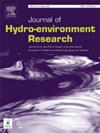干旱区流域生态指标间接累积效应的表征与预测
IF 2.3
3区 环境科学与生态学
Q2 ENGINEERING, CIVIL
引用次数: 0
摘要
生态系统的稳定性从根本上取决于各种生态过程之间的动态和互惠关系。然而,对这些过程的时空动态,特别是它们在空间上的累积效应的全面认识仍然不够充分。本文对2000 - 2020年塔里木河干旱区主要生态指标进行了系统分析。分析的主要生态指标包括叶面积指数(LAI)、总初级生产力(GPP)、蒸散发(ET)和水分利用效率(WUE),这些指标通过遥感、野外观测和模型预测收集。结果揭示了地表生态因子与土壤指标之间的动态相互作用,强调了生态水文关系对水资源管理和整体生态系统健康的影响。支流对干流的影响发生在20 ~ 150天的滞后时间内,呈现出正负反馈效应。当平均支流水分利用效率超过1.06时,持续1 ~ 2个月,主流水分利用效率显著提高。LAI(0.27)、植被总GPP(0.1875)、ET(0.345)和土壤含水量(0.419)均存在显著的间接累积效应。结果强调了多元线性回归模型在模拟TRB主流生态参数方面的有效性。该研究提高了对干旱环境生态系统动力学的认识,为TRB和全球类似地区的可持续水资源管理提供了重要指导。本文章由计算机程序翻译,如有差异,请以英文原文为准。
The characterization and prediction of the indirect cumulative effects on ecological indicators in arid watersheds
The stability of ecosystems fundamentally depends on dynamic and mutualistic relationships among various ecological processes. However, comprehensive insights into the spatiotemporal dynamics of these processes, particularly their cumulative effects in space, remain insufficiently developed. This study systematically analyzed key ecological indicators in the arid Tarim River Basin (TRB) of northwestern China from 2000 to 2020. Key ecological indicators analyzed included Leaf Area Index (LAI), Gross Primary Productivity (GPP), Evapotranspiration (ET), and Water Use Efficiency (WUE), collected through remote sensing, field observations, and model prediction. The results revealed the dynamic interactions between surface ecological factors and soil indicators, emphasizing the influence of ecological-hydrological relationships on water resource management and overall ecosystem health. The influences of tributaries on the mainstream occurred within a 20 to 150-day time lag, presenting both positive and negative feedback effects. Furthermore, when the average tributary WUE surpassed 1.06, it was sustained for 1 to 2 months, accompanied by a marked increase in the mainstream’s WUE. Significant positive indirect cumulative effects were observed for LAI (0.27), total vegetation GPP (0.1875), ET (0.345), and soil moisture content (0.419). The results emphasize the effectiveness of multiple linear regression models in simulating ecological parameters within the mainstream of the TRB. This study advances the knowledge of ecosystem dynamics in arid environments and offers critical guidance for sustainable water resource management in the TRB and similar regions globally.
求助全文
通过发布文献求助,成功后即可免费获取论文全文。
去求助
来源期刊

Journal of Hydro-environment Research
ENGINEERING, CIVIL-ENVIRONMENTAL SCIENCES
CiteScore
5.80
自引率
0.00%
发文量
34
审稿时长
98 days
期刊介绍:
The journal aims to provide an international platform for the dissemination of research and engineering applications related to water and hydraulic problems in the Asia-Pacific region. The journal provides a wide distribution at affordable subscription rate, as well as a rapid reviewing and publication time. The journal particularly encourages papers from young researchers.
Papers that require extensive language editing, qualify for editorial assistance with American Journal Experts, a Language Editing Company that Elsevier recommends. Authors submitting to this journal are entitled to a 10% discount.
 求助内容:
求助内容: 应助结果提醒方式:
应助结果提醒方式:


